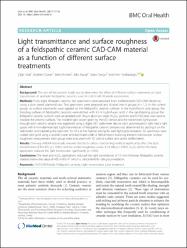Light transmittance and surface roughness of a feldspathic ceramic CAD-CAM material as a function of different surface treatments

Göster/
Erişim
info:eu-repo/semantics/openAccessAttribution 4.0 Internationalhttps://creativecommons.org/licenses/by/4.0/Tarih
2016Üst veri
Tüm öğe kaydını gösterKünye
Ural, Ç., Duran, İ., Evmek, B., Kavut, İ., Cengiz, S. ve Yüzbaşıoğlu, E. (2016). Light transmittance and surface roughness of a feldspathic ceramic CAD-CAM material as a function of different surface treatments. BMC Oral Health, 17. https://dx.doi.org/10.1186/s12903-016-0245-5Özet
Background: The aim of the present study was to determine the effect of different surface treatments on light transmission of aesthetic feldspathic ceramics used in CAD-CAM chairside restorations. Methods: Forty eight feldspatic ceramic test specimens were prepared from prefabricated CAD-CAM blocks by using a slow speed diamond saw. Test specimens were prepared and divided into 4 groups (n = 12). In the control group, no surface treatments were applied on the feldspathic ceramic surfaces. In the hydrofluoric acid group, the bonding surfaces of feldspathic ceramics were etched with 9.5 % hydrofluoric acid. In the sandblasting group the feldspathic ceramic surfaces were air-abraded with 30-µm alumium oxide (Al2O3) particles and Er:YAG laser was used to irradiate the ceramic surfaces. The incident light power given by the LED device and the transmitted light power through each ceramic sample was registered using a digital LED radiometer device. Each polymerization light had a light guide with 8-mm-diameter tips. Light transmission of feldspathic ceramic samples was determined by placing it on the radiometer and irradiating the specimen for 10 s at the highest setting for each light polymerization. All specimens were coated with gold using a sputter coater and examined under a field emission scanning electron microscope. Surface roughness measurement each group were evaluated with 3D optical surface and tactile profilometers. Results: One-way ANOVA test results revealed that both surface conditioning method significantly affect the light transmittance (F:412.437; p < 0.001) and the surface roughness values (F:16.386; p < 0.001). Al2O3 and Er-YAG laser application reduced the light transmission significantly (p < 0.05). Conclusions: The laser and Al2O3 applications reduced the light transmission of 1.5 mm thickness feldspathic ceramic material below the value of 400 mW/cm2 which is critical limit for safe polymerization.
WoS Q Kategorisi
Q2Scopus Q Kategorisi
Q1Kaynak
BMC Oral HealthCilt
17Koleksiyonlar
- Makale Koleksiyonu [300]
- Makale Koleksiyonu [559]
- PubMed İndeksli Yayınlar Koleksiyonu [4223]
- Scopus İndeksli Yayınlar Koleksiyonu [6561]
- WoS İndeksli Yayınlar Koleksiyonu [6621]


















